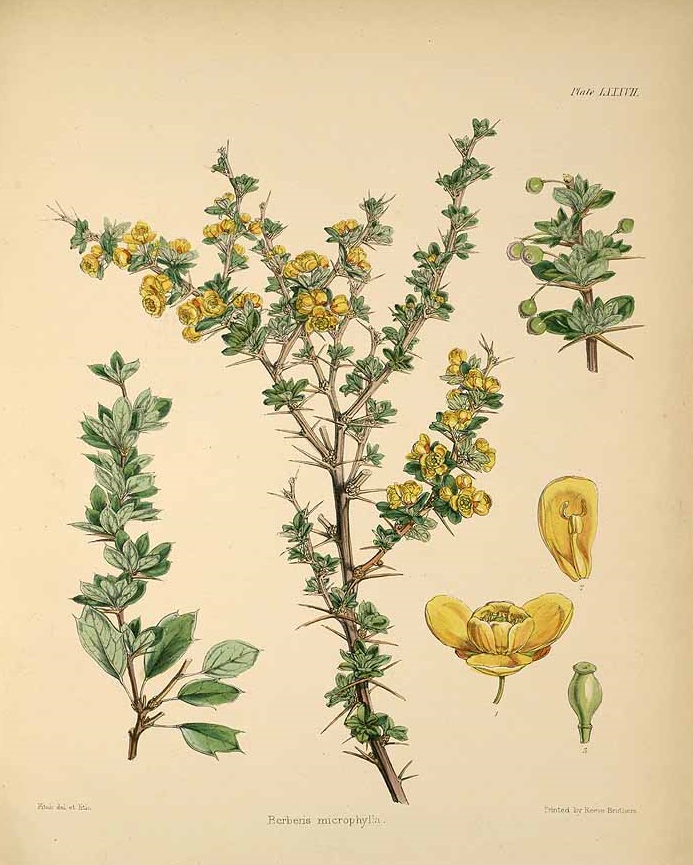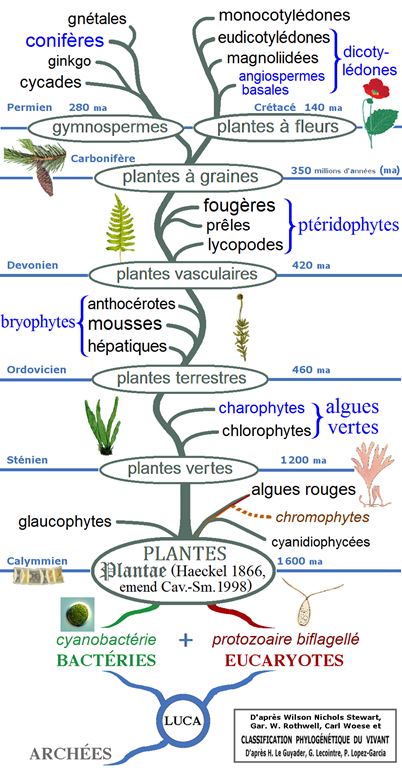Berberis buxifolia
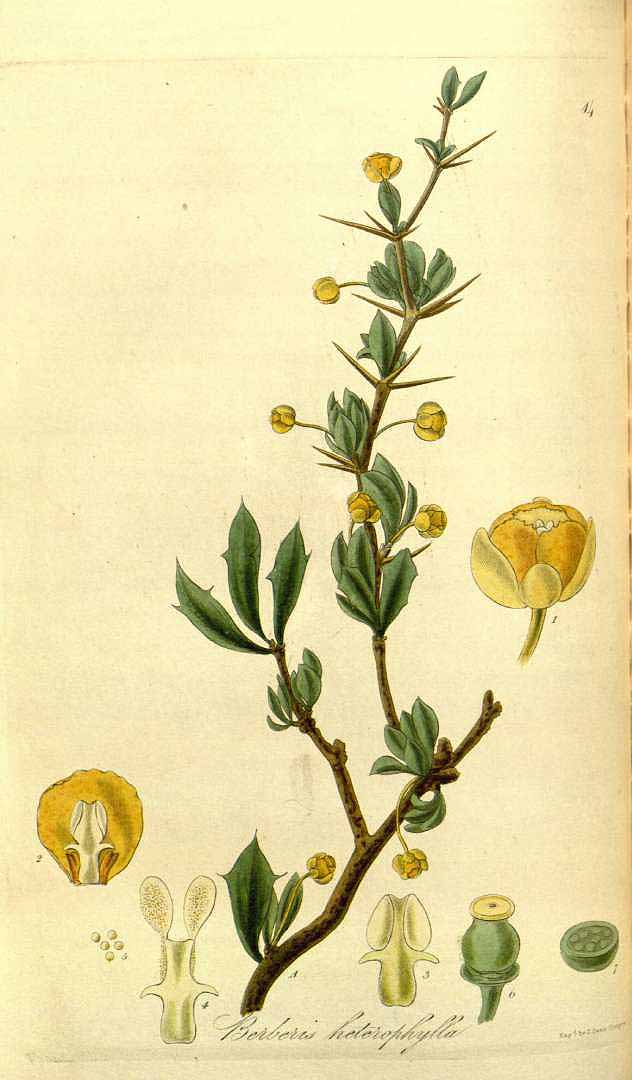
Un arbuste à feuilles persistantes. Il perd ses feuilles lors des hivers froids. Il est dressé et atteint 2,4 m de haut. Il s'étend sur 3 m de large. Les branches se cambre ... (traduction automatique)
→suite
Berberis buxifolia 
Note alimentaire ![]()
![]()
![]()
![]()
Un arbuste à feuilles persistantes. Il perd ses feuilles lors des hivers froids. Il est dressé et atteint 2,4 m de haut. Il s'étend sur 3 m de large. Les branches se cambrent. Les feuilles sont vert foncé. Les feuilles sont étroitement ovales et ont une épine à l'extrémité. Les fleurs sont jaune orangé foncé... (traduction automatique) →suite
Classification
- Classique : en haut de l\'écran, sous le coeur.
- Phylogénétique :
- Clade 4 : Angiospermes ;
- Clade 3 : Dicotylédones_vraies ;
- Ordre APN : Ranunculales ;
- Famille APN : Berberidaceae ;
Illustration : cet arbre phylogénétique des plantes montre les principaux clades et groupes traditionnels (monophylétiques en noir et paraphylétiques en bleu).
Dénominations
✖- Nom botanique : Berberis buxifolia Lam.
- Synonymes : Berberis dulcis Sweet
- Noms anglais et locaux : Magellan barberry
Description et culture
✖- dont infos de "FOOD PLANTS INTERNATIONAL" :
Description :
Un arbuste à feuilles persistantes. Il perd ses feuilles lors des hivers froids. Il est dressé et atteint 2,4 m de haut. Il s'étend sur 3 m de large. Les branches se cambrent. Les feuilles sont vert foncé. Les feuilles sont étroitement ovales et ont une épine à l'extrémité. Les fleurs sont jaune orangé foncé. Ils sont à l'aisselle des feuilles supérieures. Ils peuvent être seuls ou par paires. Le fruit est violet foncé ou noir. Ils mesurent 8 mm de diamètre. Probablement maintenant Berberis microphylla{{{0(+x) (traduction automatique).
Original : An evergreen shrub. It loses its leaves in cold winters. It is erect and grows 2.4 m high. It spreads 3 m wide. The branches arch over. The leaves are dark green. The leaves are narrowly oval and have a spine at the end. The flowers are deep orange-yellow. They are in the axils of upper leaves. They can be single or in pairs. The fruit are dark purple or black. They are 8 mm across. Probably now Berberis microphylla{{{0(+x).
 Consommation (rapports de comestibilité, parties utilisables et usages alimentaires correspondants)
Consommation (rapports de comestibilité, parties utilisables et usages alimentaires correspondants)
✖
Parties comestibles :
fruit{{{0(+x) (traduction automatique).Original : Fruit{{{0(+x).
Détails :
Les fruits mûrs sont consommés crus. Le fruit peut être utilisé pour les tartes et les tartes{{{0(+x) (traduction automatique).Original : The ripe fruit are eaten raw. The fruit can be used for pies and tarts{{{0(+x).
Partie testée :
fruit{{{0(+x) (traduction automatique). Original : Fruit{{{0(+x)| Taux d'humidité | Énergie (kj) | Énergie (kcal) | Protéines (g) |
|---|---|---|---|
| / | / | / | / |
| Pro- vitamines A (µg) |
Vitamines C (mg) | Fer (mg) | Zinc (mg) |
| / | / | / | / |
 Risques et précautions à prendre
Risques et précautions à prendre
✖
néant, inconnus ou indéterminés.
Galerie(s)
✖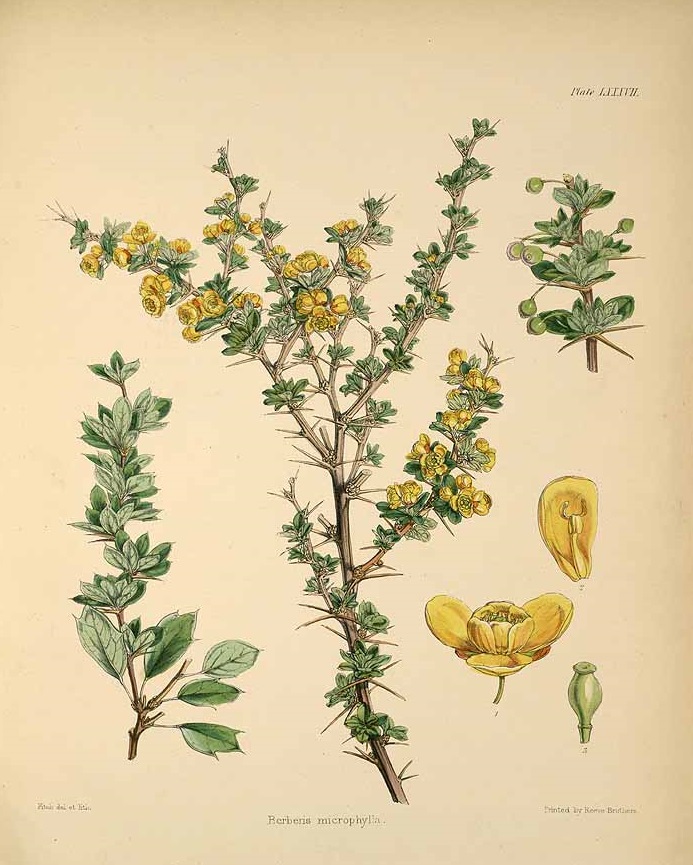
Par Hooker, J.D., botany of the Antarctic voyage of H.M. discovery ships Erebus and Terror in the Years 1839-1843, under the command of Captain Sir James Clark Ross (1844-1860) Bot. Antarct. Voy. vol. 1(2): , via plantillustrations
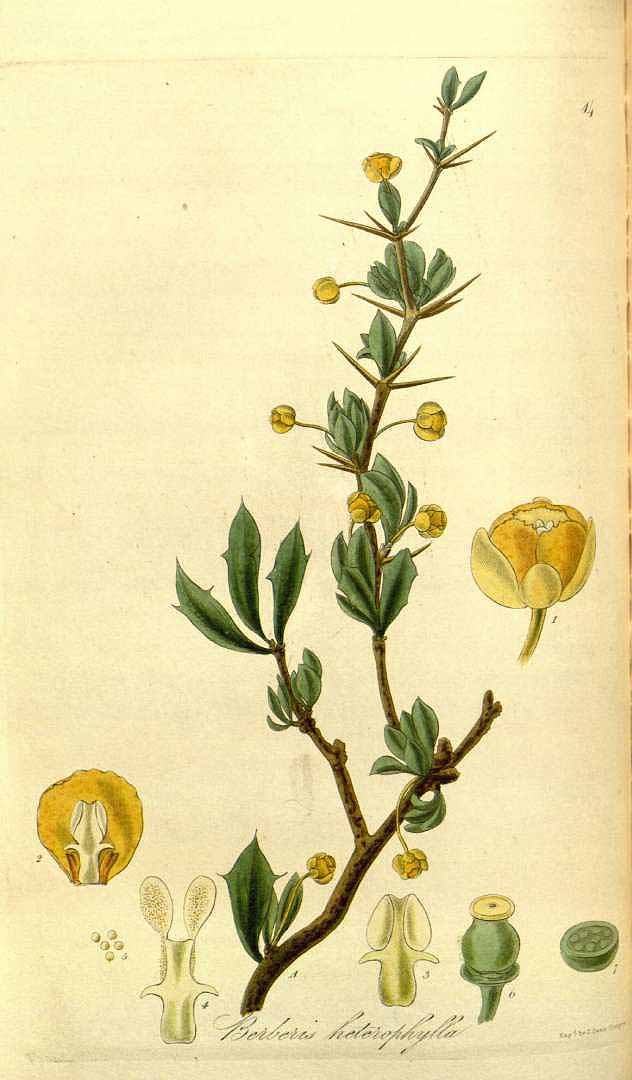
Par Hooker, W.J., Exotic Flora (1823-1827) Exot. Fl. vol. 1 (1823), via plantillustrations
![Illustration Berberis buxifolia, Par Paxton, J., Magazine of botany and register of flowering plants [J. Paxton] (1834-1849) Paxton?s Mag. Bot. vol. 10 (1843), via plantillustrations](https://lepotager-demesreves.fr/inc/images/illustrations/berberis_buxifolia3.jpg )
Par Paxton, J., Magazine of botany and register of flowering plants [J. Paxton] (1834-1849) Paxton?s Mag. Bot. vol. 10 (1843), via plantillustrations
Autres infos
✖dont infos de "FOOD PLANTS INTERNATIONAL" :
Statut :
C'est une plante alimentaire cultivée{{{0(+x) (traduction automatique).
Original : It is a cultivated food plant{{{0(+x).
Distribution :
Les plantes sont résistantes au froid. Ils peuvent tolérer des températures jusqu'à -15 ° C. Il convient aux zones de rusticité 6-9{{{0(+x) (traduction automatique).
Original : Plants are cold hardy. They can tolerate temperatures down to -15°C. It suits hardiness zones 6-9{{{0(+x).
Localisation :
Argentine, Australie, Grande-Bretagne, Chili, Europe, Amérique du Sud *{{{0(+x) (traduction automatique).
Original : Argentina, Australia, Britain, Chile, Europe, South America*{{{0(+x).
Notes :
Il existe environ 450 à 500 espèces de Berberis{{{0(+x) (traduction automatique).
Original : There are about 450-500 Berberis species{{{0(+x).
Liens, sources et/ou références
✖Sources et/ou références :
5"Plants For A Future" (en anglais) ;
dont livres et bases de données : 0"Food Plants International" (en anglais) ;
Recherche de/pour :
- "Berberis buxifolia" sur Google (pages et
images) ;
INPI (en anglais) ;
TROPICOS (en anglais) ;
Tela Botanica ;
Pl@ntNet ;
Pl@ntUse ;
- "Berberis buxifolia" sur Google (pages et
images) ;
INPI (en anglais) ;
TROPICOS (en anglais) ;
Tela Botanica ;
Pl@ntNet ;
Pl@ntUse ;
Espèces du même genre (Berberis)
✖50 taxons (sur 111)
- Berberis actinacantha
- Berberis aggregata
- Berberis amoena
- Berberis amurensis
- Berberis angulosa
- Berberis aquifolium Pursh (Mahonia à feuilles de houx)
- Berberis aristata
- Berberis asiatica
- Berberis atrocarpa
- Berberis barandana
- Berberis bidentata
- Berberis boliviana
- Berberis buxifolia
- Berberis bykovianas
- Berberis calliantha
- Berberis calliobotrys
- Berberis canadensis
- Berberis capillaris
- Berberis ceratophylla
- Berberis chengii
- Berberis chilensis Gillies ex Hook. & Arn.
- Berberis chinensis
- Berberis chingii
- Berberis chitria
- Berberis circumserrata
- Berberis commutata
- Berberis concinna
- Berberis cooperi
- Berberis crataegina
- Berberis cretica
- Berberis darwinii Hook. (Épine-vinette de darwin)
- Berberis empetrifolia Lam. (Épine-vinette à feuilles de camarine)
- Berberis erythroclada
- Berberis everestiana
- Berberis everstiana
- Berberis fendleri
- Berberis flexuosa
- Berberis gagnepainii
- Berberis ganpinensis
- Berberis georgii
- Berberis glauca
- Berberis glaucocarpa
- Berberis glomerata
- Berberis gracilis Hartw. ex Benth. (Épine-vinette mexicaine)
- Berberis haematocarpa
- Berberis heterophylla
- Berberis heteropoda
- Berberis holstii
- Berberis horrida
- Berberis ilicifolia
- ...
Espèces de la même famille (Berberidaceae)
✖50 taxons (sur 159)
- Achlys triphylla DC.
- Berberis actinacantha
- Berberis aggregata
- Berberis amoena
- Berberis amurensis
- Berberis angulosa
- Berberis aquifolium Pursh (Mahonia à feuilles de houx)
- Berberis aristata
- Berberis asiatica
- Berberis atrocarpa
- Berberis barandana
- Berberis bidentata
- Berberis boliviana
- Berberis buxifolia
- Berberis bykovianas
- Berberis calliantha
- Berberis calliobotrys
- Berberis canadensis
- Berberis capillaris
- Berberis ceratophylla
- Berberis chengii
- Berberis chilensis Gillies ex Hook. & Arn.
- Berberis chinensis
- Berberis chingii
- Berberis chitria
- Berberis circumserrata
- Berberis commutata
- Berberis concinna
- Berberis cooperi
- Berberis crataegina
- Berberis cretica
- Berberis darwinii Hook. (Épine-vinette de darwin)
- Berberis empetrifolia Lam. (Épine-vinette à feuilles de camarine)
- Berberis erythroclada
- Berberis everestiana
- Berberis everstiana
- Berberis fendleri
- Berberis flexuosa
- Berberis gagnepainii
- Berberis ganpinensis
- Berberis georgii
- Berberis glauca
- Berberis glaucocarpa
- Berberis glomerata
- Berberis gracilis Hartw. ex Benth. (Épine-vinette mexicaine)
- Berberis haematocarpa
- Berberis heterophylla
- Berberis heteropoda
- Berberis holstii
- Berberis horrida
- ...

